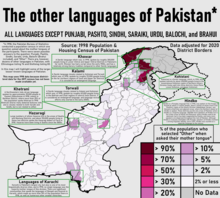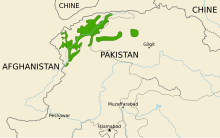Khowar
| Khowar | |
|---|---|
| کھووار | |
 Khowar written in the Khowar alphabet in Nastaliq style. | |
| Native to | Pakistan |
| Region | Chitral District |
| Ethnicity | Kho people |
Native speakers | c. 800,000 (2021)[1] |
| Khowar alphabet (In Nastaliq style.) | |
| Official status | |
| Regulated by | Association for the Promotion of Khowar[2] |
| Language codes | |
| ISO 639-3 | khw |
| Glottolog | khow1242 |
| Linguasphere | 59-AAB-aa |
 Khowar is a minor language of Pakistan which is mainly spoken in Chitral, it is given a space in this map. | |
 Areas where Khowar is spoken. | |
Khowar (کھووار), or Chitrali, is an Indo-Aryan language primarily spoken in Chitral and surrounding areas in Pakistan.[3]
Khowar is the lingua franca of Chitral,[4] and it is also spoken in the Gupis-Yasin and Ghizer districts of Gilgit-Baltistan, as well in the Upper Swat district.[5]
Speakers of Khowar have also migrated heavily to Pakistan's major urban centres, with Peshawar, Islamabad, Lahore and Karachi having significant populations. It is also spoken as a second language by the Kalash people.[6]
Names[edit]
The native name of the language is Khō-wār,[7] meaning "language" (wār) of the Kho people. During the British Raj it was known to the English as Chitrālī (a derived adjective from the name of the Chitral region) or Qāshqārī.[7] Among the Pashtuns and Badakhshanis it is known as Kashkār.[8] Another name, used by Leitner in 1880, is Arnyiá[9] or Arniya, derived from the Shina language name for the part of the Yasin (a valley in Gilgit-Baltistan) where Khowar is spoken.[7]
History[edit]
The Khowar language expanded throughout Chitral from the northern part of the region, specifically from the Mulkhow and Torkhow Valley.[10][11] According to Morgenstierne, the original abode of the Khowar language was northern Chitral in the valleys around Mastuj.[10] The Khowar language started expanding into southern Chitral around the early 14th.[10]
Khowar shares a great number of morphological characteristics with neighbouring Iranian languages of Badakhshan, pointing to a very early location of proto-Khowar in its original abode in Upper Chitral, although from its links with the Gandhari language, it likely came from further south in the first millennium BC, possibly through Swat and Dir.[11]
Georg Morgenstierne noted, "Khowar, in many respects [is] the most archaic of all modern Indian languages, retaining a great part of Sanskrit case inflexion, and retaining many words in a nearly Sanskritic form".[12]:3
Phonology[edit]
Khowar has a variety of dialects, which may vary phonemically.[13] The following tables lay out the basic phonology of Khowar.[14][15][16]
Vowels[edit]
| Front | Central | Back | |
|---|---|---|---|
| Close | i | u | |
| Mid | ɛ | ɔ | |
| Open | ɑ |
Khowar may also have nasalized vowels and a series of long vowels /ɑː/, /ɛː/, /iː/, /ɔː/, and /uː/. Sources are inconsistent on whether length is phonemic, with one author stating "vowel-length is observed mainly as a substitute one. The vowel-length of phonological value is noted far more rarely."[13] Unlike the neighboring and related Kalasha language, Khowar does not have retroflex vowels.[14]
Consonants[edit]
| Labial | Coronal | Retroflex | Palatal | Velar | Post- velar |
Glottal | ||
|---|---|---|---|---|---|---|---|---|
| Nasal | m | n | ||||||
| Stop | voiceless | p | t | ʈ | k | q | ||
| voiced | b | d | ɖ | g | ||||
| aspirated | pʰ | tʰ | ʈʰ | kʰ | ||||
| Affricate | voiceless | ts | ʈʂ | tɕ | ||||
| voiced | dz | ɖʐ | dʑ | |||||
| aspirated | tsʰ | ʈʂʰ | tɕʰ | |||||
| Fricative | voiceless | f | s | ʂ | ɕ | x | h | |
| voiced | z | ʐ | ʑ | ɣ | ||||
| Approximant | ʋ | l(ʲ) ɫ | j | (w) | ||||
| Rhotic | ɾ | |||||||
Allophones of /x ɣ h ʋ ɾ/ are heard as sounds [χ ʁ ɦ w ɹ].[16] /q x ɣ f/ are restricted to Perso-Arabic loanwords in most IA languages but they occur natively in Khowar.[17][full citation needed]
Tone[edit]
Khowar, like many Dardic languages, has either phonemic tone or stress distinctions.[18]
Further reading[edit]
References[edit]
- ↑ "Khowar language is losing its essence -Faizan Aziz - Chitral Times". 2 December 2021. Retrieved 1 May 2023.
Khowar is one of the regional languages of Pakistan. It is spoken in different parts of Pakistan and more than 0.8 million people speak Khowar over in Chitral, Gilgit-Baltistan, and Swat Valley. Meanwhile, in Chitral, Khowar is considered as a lingua franca or the main communicative language of the area.
- ↑ Faizi, Inayatullah. "Development of Khowar as a Literacy Language, Results of interaction between linguists and language community: Case study in Chitral, Northern Pakistan" (PDF). NWFP-Pakistan: Govt Degree College Chitral.
- ↑ Jain, Danesh; Cardona, George (26 July 2007). The Indo-Aryan Languages. Routledge. p. 843. ISBN 978-1-135-79711-9.
- ↑ Jain, Danesh; Cardona, George (26 July 2007). The Indo-Aryan Languages. Routledge. p. 843. ISBN 978-1-135-79711-9.
- ↑ Cardona, George (2007). The Indo-Aryan Languages. p. 843.
- ↑ Heegård Petersen, Jan (30 September 2015). "Kalasha texts – With introductory grammar". Acta Linguistica Hafniensia. 47 (sup1): 1–275. doi:10.1080/03740463.2015.1069049. ISSN 0374-0463. S2CID 218660179.
- ↑ 7.0 7.1 7.2 Template:LSI
- ↑ O'Brien, Donatus James Thomond (1895). Grammar and vocabulary of the K̲h̲owâr dialect (Chitrâli). Lahore: Civil and military gazette press. p. i.
- ↑ Leitner, Gottlieb William (1880). Kafiristan. Section 1: the Bashgeli Kafirs and their language. Lahore: Dilbagroy. p. 43. Retrieved 6 June 2016.
- ↑ 10.0 10.1 10.2 Rensch, Calvin Ross (1992). Sociolinguistic Survey of Northern Pakistan: Languages of Chitral (PDF). National Institute of Pakistan Studies, Quaid-i-Azam University. pp. 28–29, 98–99.
- ↑ 11.0 11.1 Dani, Ahmad Hasan (2001). History of Northern Areas of Pakistan: Upto 2000 A.D. Sang-e-Meel Publcations. p. 66. ISBN 978-969-35-1231-1.
- ↑ Morgenstierne, Georg (1974). "Languages of Nuristan and surrounding regions". In Jettmar, Karl; Edelberg, Lennart (eds.). Cultures of the Hindukush: selected papers from the Hindu-Kush Cultural Conference held at Moesgård 1970. Beiträge zur Südasienforschung, Südasien-Institut Universität Heidelberg. Vol. Bd. 1. Wiesbaden: Franz Steiner. pp. 1–10. ISBN 978-3-515-01217-1.
The main language of Chitral is Khowar, in many respects the most archaic of all modern Indian languages, retaining a great part of Sanskrit case inflexion, and retaining many words in a nearly Sanskritic form.
- ↑ 13.0 13.1 Edelman, D. I. (1983). The Dardic and Nuristani Languages. Moscow: Institut vostokovedenii︠a︡ (Akademii︠a︡ nauk SSSR). p. 210.
- ↑ 14.0 14.1 Bashir, Elena L. (1988), "Topics in Kalasha Syntax: An areal and typological perspective" (PDF), Ph.D. Dissertation, University of Michigan: 37–40
- ↑ Bashir, Elena L.; Nigah, Maula; Baig, Rahmat Karim (2004), A Digital Khowar-English Dictionary with Audio
- ↑ 16.0 16.1 Liljegren, H.; Khan, A. (2017). "Khowar". Journal of the International Phonetic Association. 47 (2): 219–229. doi:10.1017/S0025100316000220. S2CID 232348235.
- ↑ Cardona, Jain (2003), p. 932.
- ↑ Baart, Joan L. G. (2003), Tonal features in languages of northern Pakistan (PDF), National Institute of Pakistan Studies, Quaid-i-Azam University and Summer Institute of Linguistics, pp. 3, 6
Additional references[edit]
- Bashir, Elena (2001) "Spatial Representation in Khowar". Proceedings of the 36th Annual Meeting of the Chicago Linguistic Society. Chicago: Chicago Linguistic Society.
- Decker, D. Kendall (1992). Languages of Chitral. ISBN 969-8023-15-1.
- L'Homme, Erik (1999) Parlons Khowar. Langue et culture de l'ancien royaume de Chitral au Pakistan. Paris: L'Harmatta
- Morgenstierne, Georg (1936) "Iranian Elements in Khowar". Bulletin of the School of Oriental and African Studies, Vol. VIII, London.
- Badshah Munir Bukhari (2001) Khowar language. University publisher. Pakistan
- Morgenstierne, Georg (1947) "Some Features of Khowar Morphology". Norsk Tidsskrift for Sprogvidenskap, Vol. XIV, Oslo.
- Morgenstierne, Georg (1957) Sanskritic Words in Khowar. Felicitation Volume Presented to S. K. Belvalkar. Benares. 84–98 [Reprinted in Morgenstierne (1973): Irano-Dardica, 267–72]
- Mohammad Ismail Sloan (1981) Khowar-English Dictionary. Peshawar. ISBN 0-923891-15-3.
- Decker, Kendall D. (1992). Languages of Chitral (Sociolinguistic Survey of Northern Pakistan, 5). National Institute of Pakistani Studies, 257 pp. ISBN 969-8023-15-1.
- Zeal News
External links[edit]
- "Georg Morgenstierne". National Library of Norway. 2001. Retrieved 11 January 2009.
- Strand, Richard F. (2011). "Khow'ar Lexicon". Retrieved 16 January 2012.
- Strand, Richard F. (2012). "The Sound System of Khow'ar". Retrieved 16 January 2012.
